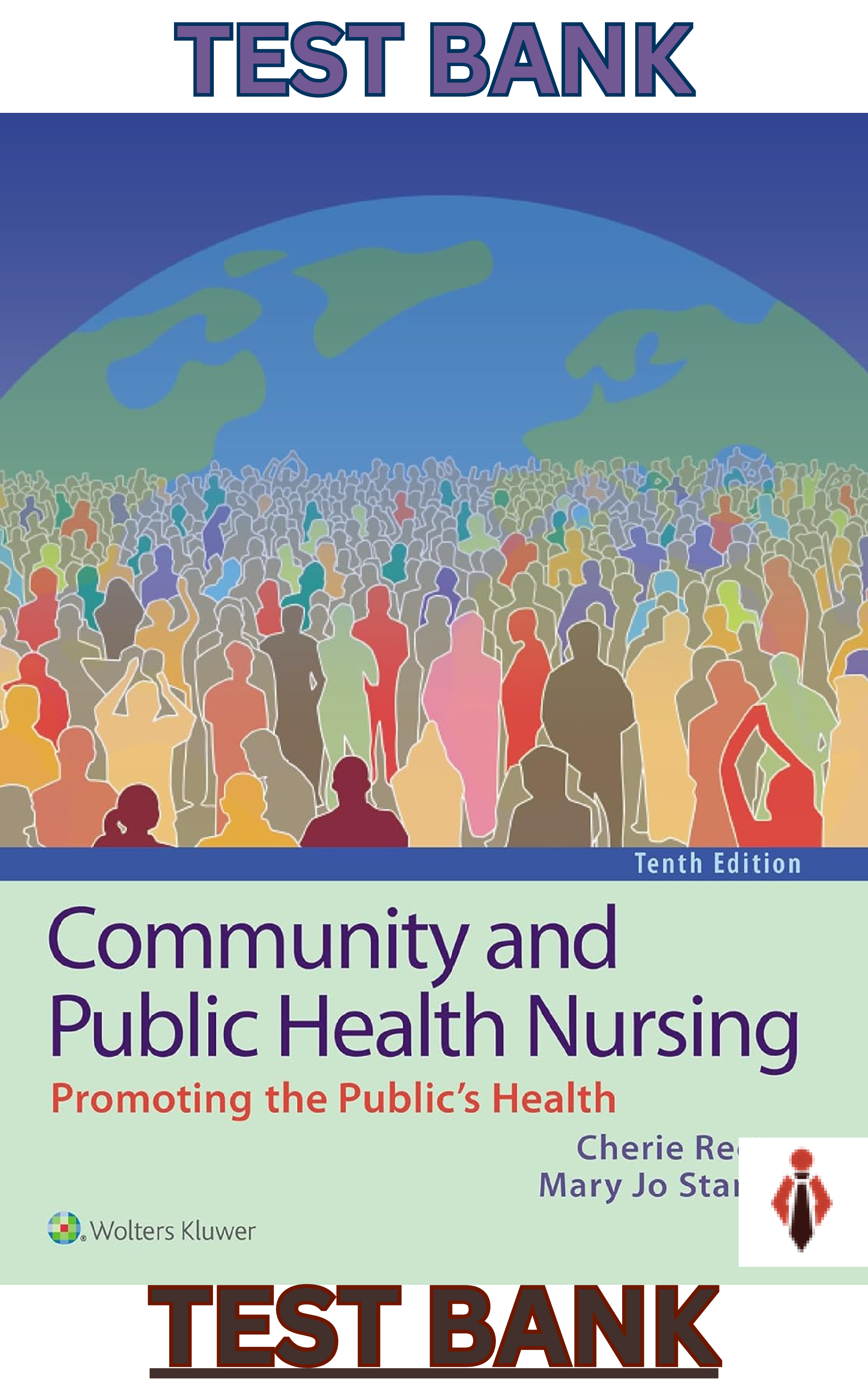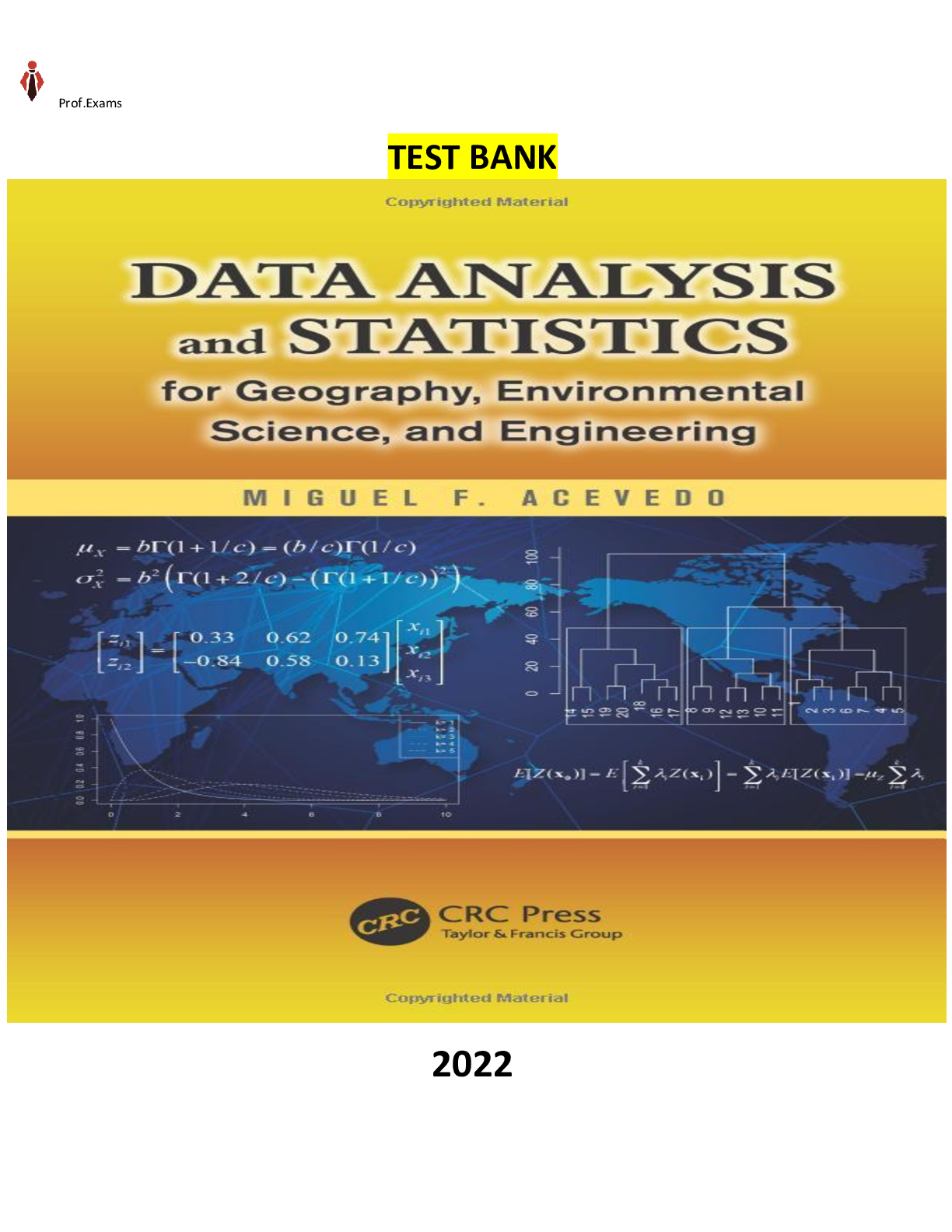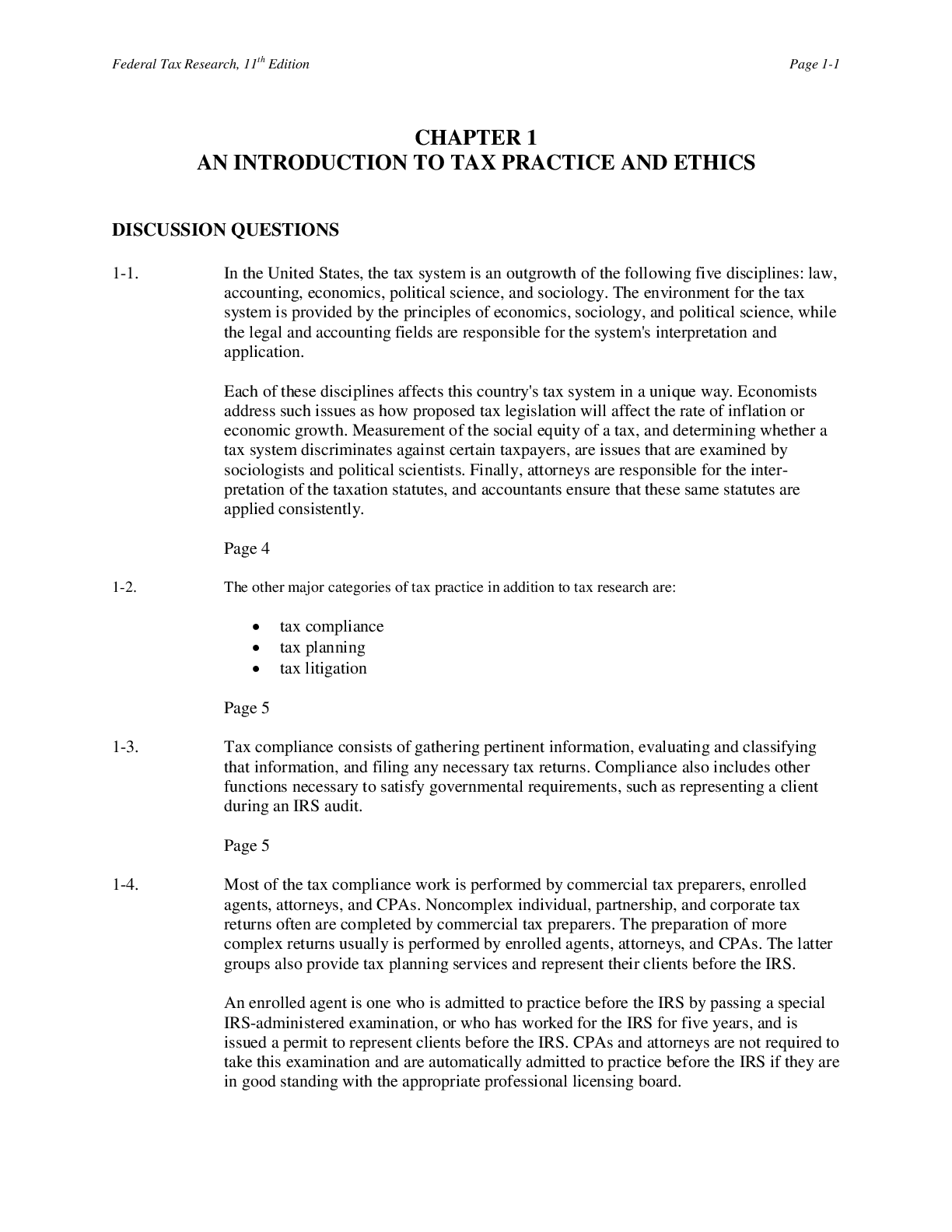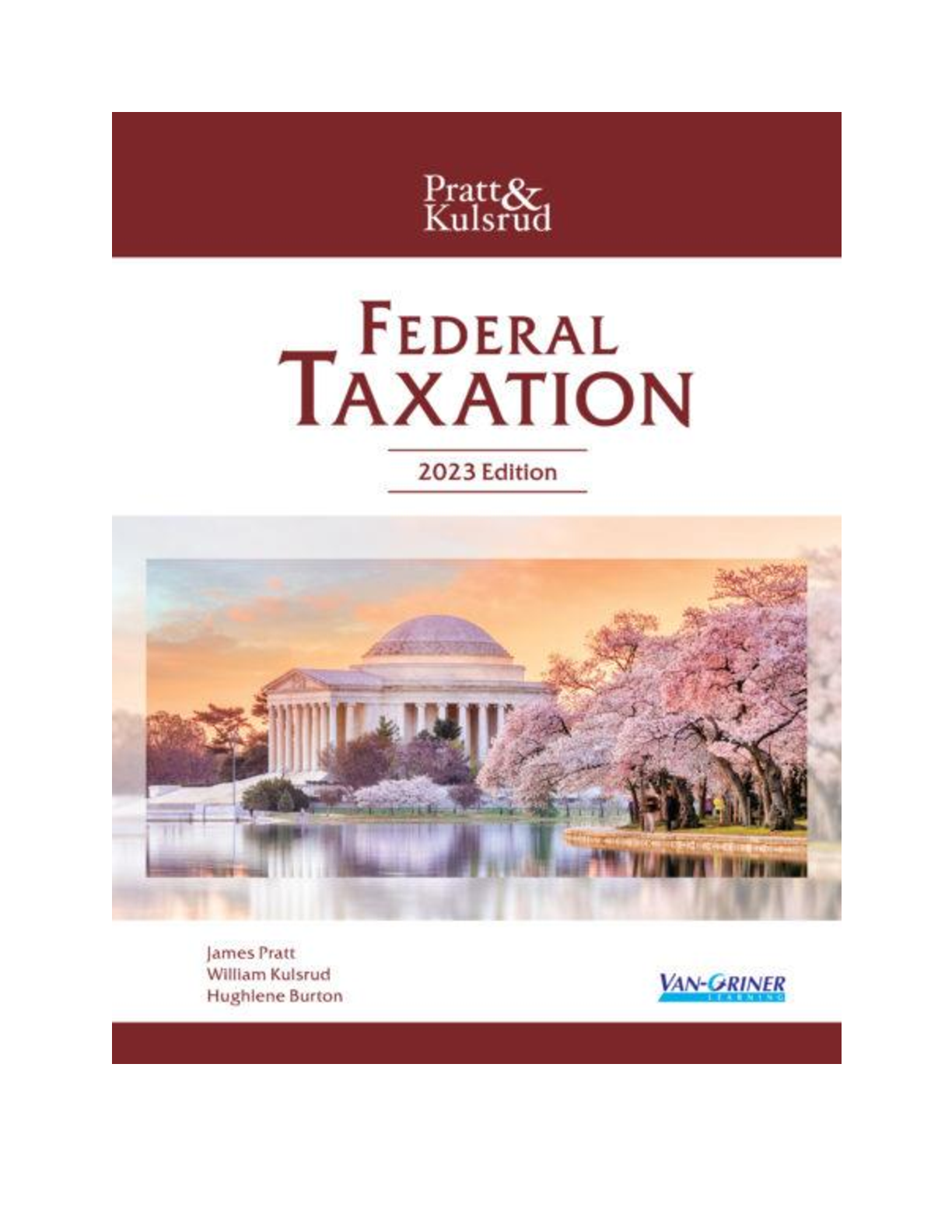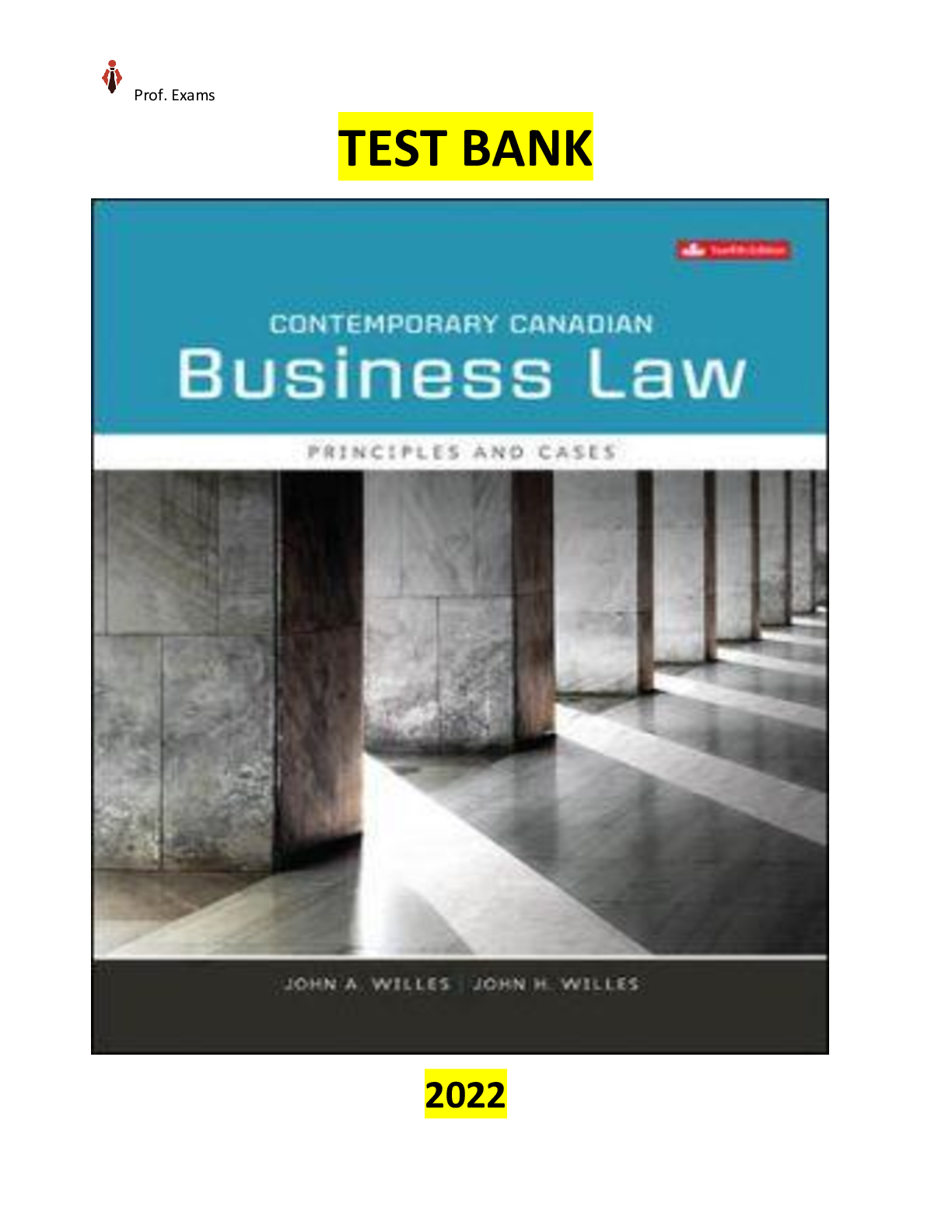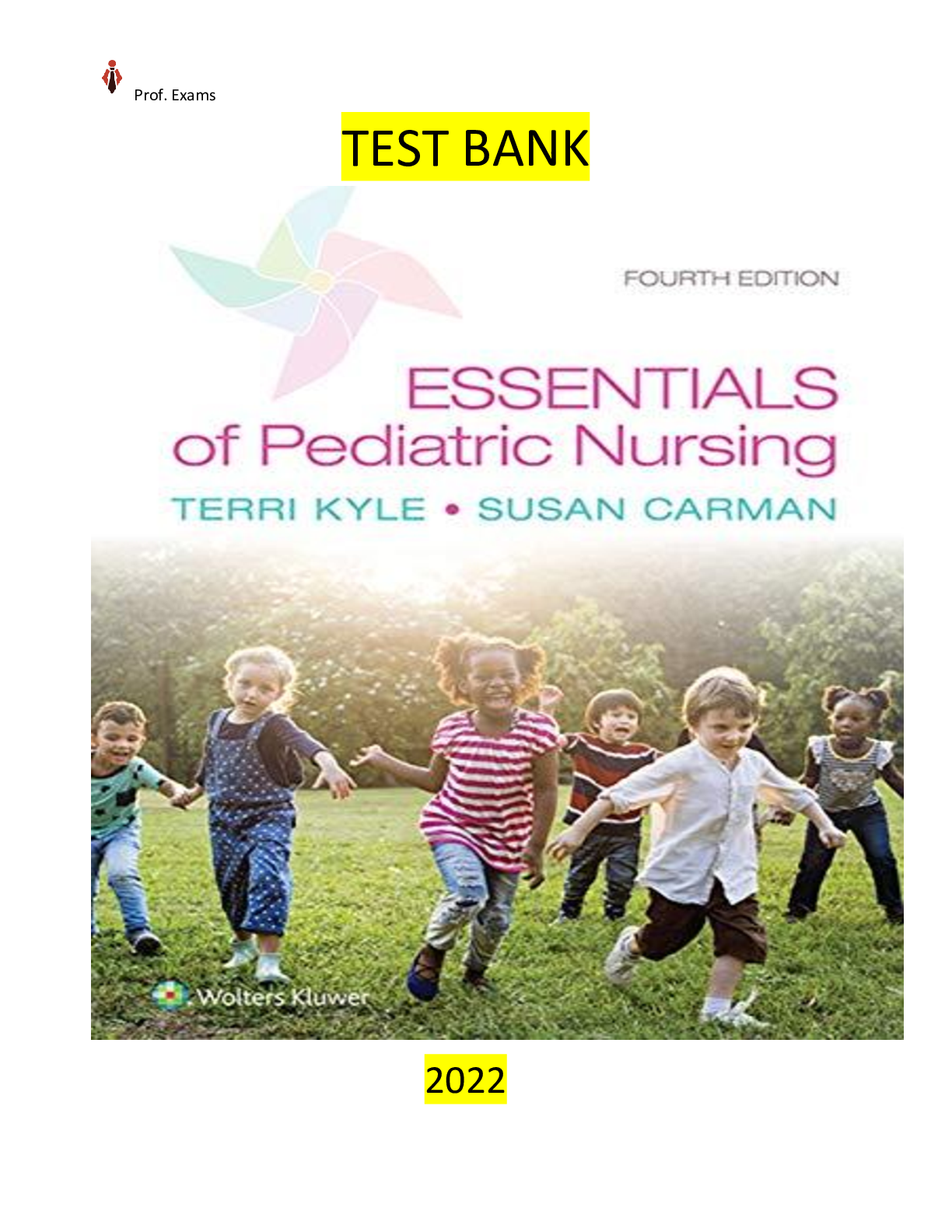Financial Accounting > TEST BANK > COMPLETE - Elaborated Test Bank for Federal Tax Research 12Ed.by Roby Sawyers & Steven Gill. ALL Cha (All)
COMPLETE - Elaborated Test Bank for Federal Tax Research 12Ed.by Roby Sawyers & Steven Gill. ALL Chapters Included 1-13. 157 Pages of Content- A+ Graded for 2023
Document Content and Description Below
COMPLETE - Elaborated Test Bank for Federal Tax Research 12Ed.by Roby Sawyers & Steven Gill. ALL Chapters Included 1-13. 157 Pages of Content- A+ Graded for 2023 COMPLETE - Elaborated Test Bank fo... r Federal Tax Research 12Ed.by Roby Sawyers & Steven Gill COMPLETE Elaborated Test Bank for Federal Tax Research 12Ed. by Roby Sawyers Steven Gill 2022 Prof.Exams TABLE OF CONTENTS Part I: The Tax Research Environment Chapter 1: Introduction to Tax Practice and Ethics 1.1 Elements of Tax Practice 1.2 Rules and Ethics in Tax Practice 1.3 Nonregulatory Ethical Behavior Models 1.4 Legal Research by Certified Public Accountants Chapter 2: Tax Research Methodology 2.1. The Tax Research Process 2.2. Conducting Tax Research Using Online Services 2.3. Using a Commercial Online Tax Service to Conduct Tax Research 2.4. Tax Research Practical Considerations 2.5. Research and Tax on the CPA Exam Part II: Primary Sources of Federal Tax Law Chapter 3: Constitutional and Legislative Sources 3.1. Sources of Legislative Tax Law 3.2. History of U.S. Taxation 3.3. Who Pays the Income Tax 3.4. U.S. Constitution 3.5. Tax Treaties 3.6. The Legislative Process 3.7. Internal Revenue Code Chapter 4: Administrative Regulations and Rulings 4.1. Regulations 4.2. Revenue Rulings 4.3. Revenue Procedures 4.4. Letter Rulings 4.5. Internal Revenue Bulletin 4.6. Acquiescence’s and Non - acquiescence’s 4.7. Chief Counsel Memoranda 4.8. Announcements and Notices 4.9. IRS Publications Chapter 5: Judicial Interpretations 5.1. Federal Court System 5.2. Legal Concepts and Terminology 5.3. U.S. Tax Court 5.4. District Courts 5.5. Court of Federal Claims 5.6. Courts of Appeals 5.7. Supreme Court 5.8. Case Briefs and Headnotes Prof.Exams Part III: Research Tools Chapter 6: Thomson Reuters Checkpoint 6.1. Using Tax Services for Research 6.2. Thomson Reuters Checkpoint 6.3. Illustrative Research Example 6.4. Databases 6.5. Finding Relevant Tax Information 6.6. Citators 6.7. Other Tax Law Sources Chapter 7: CCH Answer Connect 7.1. Using Tax Services for Research 7.2. Answer Connect 7.3. Illustrative Research Example 7.4. Databases 7.5. Finding Relevant Tax Information 7.6. Citators 7.7. Other Tax Law Sources Chapter 8: Other Tax Services and Tax Periodicals 8.1. Bloomberg Tax 8.2. Westlaw 8.3. LexisNexis 8.4. Tax Notes 8.5. Tax Periodicals Chapter 9: Multijurisdictional Taxes 9.1. State and Local Tax 9.2. Importance of State and Local Taxes 9.3. Legal Perspective 9.4. State Tax Structure 9.5. Multistate Taxation 9.6. Illustrative Research Example 9.7. Checkpoint State and Local Tax (SALT) Service 9.8. CCH Answer Connect State 9.9. Bloomberg Tax 9.10. Lexis Advance Tax 9. 11. Nexis Uni 9.12. Westlaw State Services 9.13. Other Resources 9.14. Periodicals and Internet Sites 9.15. International Taxation 9.16. Researching International Tax 9.17. Checkpoint 9.18. CCH Answer Connect 9.19. Bloomberg Tax Prof.Exams 9. 20. Lexis Advance Tax 9. 21. Tax Analysts 9. 22. Internet Sites Part IV: Implementing the Research Tools Chapter 10: Communicating Research Results 10.1. Communications and the Tax Professional 10.2. The Heart of Tax Research Communication: The Research Memo 10.3. Providing Tax Advice to a Client 10.4. Comprehensive Illustration of Client File 10. 5. Oral Presentations of Research Results Chapter 11: Tax Planning 11.1. The Economics of Tax Planning 11.2. Tax Rate Terminology 11.3. Tax Planning in Perspective 11.4. Fundamentals of Tax Planning 11.5. Avoiding Tax Traps Chapter 12: Working with the IRS 12.1. The Internal Revenue Service 12.2. The Audit Process 12.3. Examinations 12.4. The Appeals Process 12.5. Entering the Judicial System 12.6. Statutes of Limitations 12.7. Statutory Agreements 12.8. Taxpayer Rights Chapter 13: Tax Practice and Administration 13.1. Taxpayer Penalties 13.2. Relief from Joint and Several Liability 13.3. Penalties on Return Preparers 13.4. Injunctions 13.5. Interest Federal Tax Research, 12th Edition Page 1-1 CHAPTER 1 AN INTRODUCTION TO TAX PRACTICE AND ETHICS DISCUSSION QUESTIONS 1-1. In the United States, the tax system is an outgrowth of the following five disciplines: law, accounting, economics, political science, and sociology. The environment for the tax system is provided by the principles of economics, sociology, and political science, while the legal and accounting fields are responsible for the system's interpretation and application. Each of these disciplines affects this country's tax system in a unique way. Economists address such issues as how proposed tax legislation will affect the rate of inflation or economic growth. Measurement of the social equity of a tax, and determining whether a tax system discriminates against certain taxpayers, are issues that are examined by sociologists and political scientists. Finally, attorneys are responsible for the interpretation of the taxation statutes, and accountants ensure that these same statutes are applied consistently. Page 4 1-2. The other major categories of tax practice in addition to tax research are: • tax compliance • tax planning • tax litigation Page 5 1-3. Tax compliance consists of gathering pertinent information, evaluating and classifying that information, and filing any necessary tax returns. Compliance also includes other functions necessary to satisfy governmental requirements, such as representing a client during an IRS audit. Page 5 1-4. Most of the tax compliance work is performed by commercial tax preparers, enrolled agents, attorneys, and CPAs. Noncomplex individual, partnership, and corporate tax returns often are completed by commercial tax preparers. The preparation of more complex returns usually is performed by enrolled agents, attorneys, and CPAs. The latter groups also provide tax planning services and represent their clients before the IRS. An enrolled agent is one who is admitted to practice before the IRS by passing a special IRS- administered examination, or who has worked for the IRS for five years, and is issued a permit to represent clients before the IRS. CPAs and attorneys are not required to take this examination and are automatically admitted to practice before the IRS if they are in good standing with the appropriate professional licensing board. Page 5 and Circular 230 Page 1-2 SOLUTIONS MANUAL 1-5. Tax planning is the process of arranging one's financial affairs to minimize any tax liability. Much of modern tax practice centers around this process, and the resulting outcome is tax avoidance. There is nothing illegal or immoral in the avoidance of taxation, as long as the taxpayer remains within legal bounds. In contrast, tax evasion constitutes the illegal nonpayment of a tax and cannot be condoned. Activities of this sort clearly violate existing legal constraints and fall outside of the domain of the professional tax practitioner. Page 6 1-6. In an open tax planning situation, the transaction is not yet complete, therefore, the tax practitioner maintains some degree of control over the potential tax liability, and the transaction may be modi- fied to achieve a more favorable tax treatment. In a closed transaction however, all of the pertinent actions have been completed, and tax planning activities may be limited to the presentation of the situation to the government in the most legally advantageous manner possible. Page 6 1-7. Tax litigation is the process of settling a dispute with the IRS in a court of law. Typically, a tax attorney handles tax litigation that progresses beyond the final IRS appeal. Page 6 1-8. CPAs serve is a support capacity in tax litigation. Page 6 1-9. Tax research consists of the resolution of unanswered taxation questions. The tax research process includes the following: 1. Identification of pertinent issues; 2. Specification of proper authorities; 3. Evaluation of the propriety of authorities; and, 4. Application of authorities to a specific situation. Page 6 1-10. Circular 230 is issued by the Treasury Department and applies to all who practice before the IRS. Page 7 1-11. In addition to Circular 230, CPAs must follow the AICPA's Code of Professional Conduct and Statements on Standards for Tax Services. CPAs must also abide by the rules of the appropriate state board(s) of accountancy. Page 7 1-12. A return preparer must obtain 18 hours of continuing education from an IRS-approved CE Provider. The hours must include a 6 credit hour Annual Federal Tax Refresher course (AFTR) that covers filing season issues and tax law updates. The AFTR course must include a knowledge- based comprehension test administered at the conclusion of the course by the CE Provider. Limited practice rights allow individuals to represent clients whose returns they prepared and signed, but only before revenue agents, customer service representatives, and similar IRS employees. Federal Tax Research, 12th Edition Page 1-3 Page 10 and IRS.gov 1-13. False. Only communication with the IRS concerning a taxpayer's rights, privileges, or liability is included. Practice before the IRS does not include representation before the Tax Court. Page 7 1-14. Section 10.2 of Subpart A of Circular 230 defines practice before the IRS as including: matters connected with presentation to the Internal Revenue Service or any of its officers or employees relating to a client's rights, privileges, or liabilities under laws or regulations administered by the Internal Revenue Service. Such presentations include the preparation and filing of necessary documents, correspondence with, and communications to the Internal Revenue Service, and the representation of a client at conferences, hearings, and meetings. Page 7 1-15. To become an Enrolled Agent an individual can (1) pass a test given by the IRS or (2) work for the IRS for five years. Circular 230, Subpart A, Secs. 10.4 to 10.6. Page 9 1-16. Enrolled Agents must complete 72 hours of Continuing Education every three years (an average of 24 per year, with a minimum of 16 hours during any year.). Circular 230, Subpart A. §10.6. Page 9 1-17. True. As a general rule, an individual must be an enrolled agent, attorney, or CPA to represent a client before the IRS. There are limited situations where others may represent a taxpayer; however, this fact pattern is not one of them. Since Leigh did not sign the return, she cannot represent the taxpayer, only Rose can. Pages 10-11 1-18. The names of organizations that can be represented by regular full-time employees are found in Circular 230, §10.7(c). A regular full-time employee can represent the employer (individual employer). A regular full-time employee of a partnership may represent the partnership. Also, a regular full-time employee of a trust, receivership, guardianship, or estate may represent the trust, receivership, guardianship, or estate. Furthermore, a regular full-time employee of a governmental unit, agency, or authority may represent the governmental unit, agency, or authority in the course of his or her official duties. Page 10 1-19. Yes. Circular 230, Subpart A, Sec. 10.7. Page 10 1-20. True. A practitioner may be suspended or disbarred from practice before the IRS if he or she knowingly helps a suspended or disbarred person practice indirectly before the IRS. Page 12 Page 1-4 SOLUTIONS MANUAL 1-21. A practitioner may not advise a client to take a position on a document, affidavit, or other paper submitted to the Internal Revenue Service unless the position is not frivolous. Circular 230 §10.34(b) Page 14 1-22. Under Circular 230, an attorney, certified public accountant (CPA), or enrolled agent may use mass media (e.g., T.V. and the Internet) for advertising purposes. Such media may not contain false, fraudulent, unduly influencing, coercive, or unfair statements or claims. Attorneys, CPAs, and enrolled agents must also observe any applicable standards of ethical conduct adopted by the American Bar Association (ABA), the American Institute of Certified Public Accountants (AICPA), and the National Association of Enrolled Agents (NAEA). Additional standards and listing of items that may be included in mass media advertising are defined under Section 10.30 of Subpart B in Circular 230. Page 19 1-23. Under Section 10.25 of Circular 230, partners of government employees cannot represent anyone for which the government employee-partner has (or has had) official responsibility. For instance, a CPA firm with an IRS agent could not represent any taxpayer that is (or was in the past) assigned to the IRS agent-partner. Page 12 1-24. Under Section 10.21 of Circular 230, each attorney, CPA, enrolled agent, or enrolled actuary who knows that the client has not complied with the revenue laws of the United States or has made an error in or omission from any return, document, affidavit, or other paper which the client is required by the revenue laws of the United States to execute, shall advise the client promptly of the fact of such noncompliance, error, or omission. Page 11 1-25. According to Circular 230, the best practices rules are aspirational. Thus, a practitioner who fails to comply with best practices will not be subject to discipline by the IRS. Page 14 1-26. Best practices include: a. Communicating clearly with the client regarding the terms of the engagement. For example, the advisor should determine the client’s expected purpose for and use of the advice and should have a clear understanding with the client regarding the form and scope of the advice or assistance to be rendered. b. Establishing the facts, determining which facts are relevant, evaluating the reasonableness of any assumptions or representations, relating the applicable law (including potentially applicable judicial doctrines) to the relevant facts, and arriving at a conclusion supported by the law and the facts. c. Advising the client regarding the importance of the conclusions reached, including, for example, whether a taxpayer may avoid accuracy-related penalties under the Internal Revenue Code if a taxpayer acts in reliance on the advice. d. Acting fairly and with integrity in practice before the IRS. Pages 13-14 Federal Tax Research, 12th Edition Page 1-5 1-27. A practitioner must not give written advice if the practitioner: 1. bases the written advice on unreasonable factual or legal assumptions (including assumptions as to future events), 2. unreasonably relies upon representations, statements, findings, or agreements of the taxpayer or any other person, 3. does not consider all relevant facts that the practitioner knows or should know, or 4. in evaluating a Federal tax issue, takes into account the possibility that a tax return will not be audited, that an issue will not be raised on audit, or that an issue will be resolved through settlement if raised. Page 15 1-28 A preparer tax identification number (PTIN) is required of a compensated individual who prepares or assists with the preparation of all or substantially all of a tax return or claim for refund must have a preparer tax identification number (PTIN). Normally, the individual must be an attorney, CPA, EA, or tax return preparer must obtain a PTIN in order to file tax returns for clients Page 11 1-29. Individuals who prepared tax returns for compensation must follow the rules under Circular 230 Subpart B-- Duties and Restrictions Relating to Practice Before the Internal Revenue Service and Subpart C-- Sanctions for Violation of the Regulations. Thus, they are generally held to the same standards of practice as persons who are eligible to practice before the IRS (Attorneys, Certified Public Accountants (CPAs), and Enrolled Agents (EAs). Page 11 1-30. The AICPA's Code of Professional Conduct provides a philosophical foundation upon which the Rules of Conduct are based. The Principles of the Code of Professional Conduct suggest that a CPA should strive for behavior that is above the minimal level of acceptable conduct set forth by the rules. The Code was designed to provide the following: 1. A comprehensive code of ethics and professional conduct; 2. A guide for practitioners in answering complex questions; and, 3. Assurance to the public concerning the obligations and responsibilities of the accounting profession. Pages 16-17 1-31. Threats to complying with the Independence Rule include: • Members not acting with objectivity due to an adverse interest • Advocacy threats • Familiarity threats due to a long or close relationship with a client • Management participation threats • Self-interest threats • Self-review threats • Undue influence threats Page 18 Page 1-6 SOLUTIONS MANUAL 1-32. In a tax practice the CPA may be requested to blindly follow the guidelines of a government agency or the demands of an audit client. This rule prohibits such blind obedience. The code specifically recognizes that conflicts of interest may arise in tax contexts including providing tax or personal financial planning services for several members of a family whom the member knows to have opposing interests or when referring a personal financial planning or tax client to an insurance broker or other service provider which refers clients to the member under an exclusive arrangement. Page 20 1-33. The General Standards Include: 1. The CPA must be able to complete all professional services with professional competence. 2. The CPA must exercise due professional care in the performance of all professional services. 3. The CPA shall adequately plan and supervise the performance of all professional services. 4. The CPA must obtain sufficient relevant data to afford a reasonable basis for any conclusion or recommendation in connection with the performance of any professional services. Competence encompasses not only technical subject matter but also knowledge of the profession’s standards and the ability to exercise sound judgment in applying the technical knowledge. At the same time, the code is clear that the member does not assume a responsibility for infallibility of knowledge or judgment Page 21 1-34. a. No violation b. 1.520.001- Commissions and Referral Fees c. No violation d. 1.600.001- Advertising and Other Forms of Solicitation e. 1.800.001- Form of Organization and Name Rule f. 2.400.090 or 3.400.090- Acts Discreditable Rule Pages 19-21 1-35. 1.700.001 (Confidential Client Information Rule) does not apply in the following situations: 1. There is a conflict with the Compliance with Standards Rule [1.310.001] or the Accounting Principles Rule [1.320.001] 2. The CPA is served with an enforceable subpoena or summons or must comply with applicable laws and government regulations 3. There is a review of a CPA’s practice under AICPA or state society authorization 4. The CPA is responding to an inquiry of an investigative or disciplinary body of a recognized society, or the CPA is initiating a complaint with a disciplinary body Pages 19-20 1-36. The Statements on Standards for Tax Services, or SSTS, are a series of statements, issued by the AICPA, as to what constitutes appropriate standards for tax practice. The Statements also delineate a member's responsibility to clients, the public, and the profession. The stated objectives of the Statements are as follows: Federal Tax Research, 12th Edition Page 1-7 SSTS No. 1: Tax Return Positions. This statement sets forth the applicable standards for members when recommending tax return positions, or preparing or signing tax returns. This statement also addresses a member’s obligation to advise a taxpayer of relevant tax return disclosure responsibilities and potential penalties. SSTS No. 2: Answers to Questions on Returns. This statement sets forth the applicable standards for members when signing the preparer’s declaration on a tax return if one or more questions on the return have not been answered. SSTS No. 3: Certain Procedural Aspects of Preparing Returns. This statement sets forth the applicable standards for members concerning the obligation to examine or verify certain supporting data or to consider information related to another taxpayer when preparing a taxpayer’s tax return. SSTS No. 4: Use of Estimates. This statement sets forth the applicable standards for members when using the taxpayer’s estimates in the preparation of a tax return. A member may advise on estimates used in the preparation of a tax return, but the taxpayer has the responsibility to provide the estimated data. Appraisals or valuations are not considered estimates for purposes of this statement. SSTS No. 5: Departure from a Position Previously Concluded in an Administrative Proceeding or Court Decision. This statement sets forth the applicable standards for members in recommending a tax return position that departs from the position determined in an administrative proceeding or in a court decision with respect to the taxpayer’s prior return. SSTS No. 6: Knowledge of Error: Return Preparation and Administrative Proceedings. This statement sets forth the applicable standards for a member who becomes aware of (a) an error in a taxpayer’s previously filed tax return; (b) an error in a return that is the subject of an administrative proceeding, such as an examination by a taxing authority or an appeals conference; or (c) a taxpayer’s failure to file a required tax return. SSTS No. 7: Form and Content of Advice to Taxpayers. This statement sets forth the applicable standards for members concerning certain aspects of providing advice to a taxpayer and considers the circumstances in which a member has a responsibility to communicate with a taxpayer when subsequent developments affect advice previously provided. Pages 22 - 26 1-37. Under SSTS No. 1, a member should determine and comply with the standards, if any, which are imposed by the applicable taxing authority with respect to recommending a tax return position, or preparing or signing a tax return. If the applicable taxing authority has no written standards with respect to recommending a tax return position or preparing or signing a tax return, or if its standards are lower than the standards set forth in SSTS No. 1, then SSTS No. 1 must be followed. Page 22 1-38. SSTS No.1 provides that a member should have a good faith belief that a recommended position has a realistic possibility of being sustained if challenged. In addition, a member may recommend a tax return position if the member concludes that there is a reasonable basis for the position and advises the taxpayer to appropriately disclose that position. Thus, a member may prepare or sign a tax return that reflects a position if a member has a reasonable basis for the position and that position is appropriately disclosed. COMPLETE - Elaborated Test Bank for Federal Tax Research 12Ed.by Roby Sawyers & Steven Gill. ALL Chapters Included 1-13. 157 Pages of Content- A+ Graded for 2023. [Show More]
Last updated: 2 years ago
Preview 1 out of 157 pages

Buy this document to get the full access instantly
Instant Download Access after purchase
Buy NowInstant download
We Accept:

Reviews( 0 )
$25.00
Can't find what you want? Try our AI powered Search
Document information
Connected school, study & course
About the document
Uploaded On
Apr 12, 2023
Number of pages
157
Written in
Additional information
This document has been written for:
Uploaded
Apr 12, 2023
Downloads
0
Views
101


